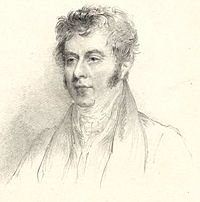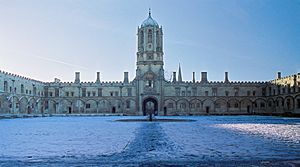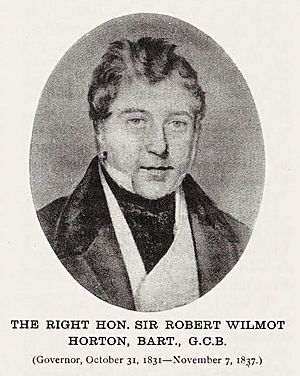Robert Wilmot-Horton facts for kids
Quick facts for kids
Sir Robert Wilmot-Horton
|
|
|---|---|

Portrait of Wilmot-Horton in the 1820s
by Richard James |
|
| 6th Governor of British Ceylon | |
| In office 23 October 1831 – 7 November 1837 |
|
| Monarch | William IV Victoria |
| Preceded by | John Wilson acting governor |
| Succeeded by | James Alexander Stewart-Mackenzie |
| Under-Secretary of State for War and the Colonies |
|
| In office 1821 – 21 January 1828 |
|
| Monarch | George IV |
| Prime Minister | The Earl of Liverpool George Canning The Viscount Goderich |
| Preceded by | Henry Goulburn |
| Succeeded by | Hon. Edward Stanley |
| Personal details | |
| Born | 21 December 1784 |
| Died | 31 May 1841 (aged 56) |
| Nationality | British |
| Spouse | Anne Horton |
| Alma mater | Christ Church, Oxford |
Sir Robert John Wilmot-Horton (born Robert John Wilmot) was an important British politician and leader. He lived from 1784 to 1841. He was known for his work in government and for his ideas about helping people move to British colonies. He served as a top official in the government department that managed the colonies. Later, he became the Governor of Ceylon (now Sri Lanka).
Contents
Early Life and Education
Robert John Wilmot was born on December 21, 1784. He was the only son of Sir Robert Wilmot, who was also a Baronet. A Baronet is a special title, like a knight, that can be passed down in a family.
Robert went to two famous schools. He studied at Eton, which is a well-known boarding school. After that, he went to Christ Church, Oxford, a college at the University of Oxford.
Political Career and Ideas
Wilmot-Horton was a member of the Tory political party. He supported ideas like free trade, which means allowing goods to be bought and sold without many government restrictions. He also supported Catholic emancipation, which meant giving Roman Catholics more rights in Britain.
He was elected as a Member of Parliament (MP) for Newcastle-under-Lyme from 1818 to 1830. An MP is a person elected to represent a group of people in the British Parliament.
From 1821 to 1827, he worked as the Under-Secretary of State for War and the Colonies. This meant he helped manage the British colonies around the world. He made changes to the Colonial Office to make it work better. He divided the British Empire into different areas, with a senior clerk in charge of each.
Wilmot-Horton is most famous for his ideas about helping poor British and Irish families move to the colonies. He believed this would help both the families and the colonies. He helped get money from Parliament in 1823 and 1825 to try out his plan. This experiment helped poor Irish families settle in Canada.
He also led a special committee in Parliament that studied emigration. He suggested a plan where poor people could get land in the colonies if they gave up their right to get help from their local parish. However, these plans were stopped after he left the Colonial Office in 1827.
Governor of Ceylon
In 1831, Wilmot-Horton was given a special honor by King William IV. He was then appointed Governor of Ceylon, which is an island nation now known as Sri Lanka.
As Governor, he made many important changes in Ceylon:
- He helped create Ceylon's first Legislative Council and Executive Committee. These groups helped govern the island.
- He ended a very old practice called "compulsory labour," where people had to work for the government for free.
- He recognized the right for people to own private property.
- He ended the government's control over the Cinnamon trade, which had been in place since the Dutch ruled the island.
- He started the first newspaper in Ceylon, called the Colombo Journal.
- He also started the first mail coach service in Asia.
- He improved the education system and opened Ceylon's first public school, the Colombo Academy. This school was later renamed Royal College and became very famous.
In 1834, he became the third Baronet after his father passed away.
After he left the Colonial Office, some people made fun of his emigration ideas. They thought he was an impractical dreamer. But Wilmot-Horton kept writing to defend his plans. He returned to Britain in 1837.
Family Life
In 1806, Wilmot-Horton married Anne Beatrix Horton. Her beauty was so striking that it inspired the famous poet Lord Byron to write his poem "She Walks in Beauty" after meeting her.
In 1823, he inherited the Catton Hall estate from his father-in-law. Because of this, he added "Horton" to his last name, becoming Wilmot-Horton. He and Anne had four sons and three daughters.
Death and Legacy
Sir Robert Wilmot-Horton passed away in May 1841, at the age of 56. His eldest son, Robert, took over the Baronetcy.
Several places were named after him:
- Horton Plains in Ceylon was named after him in 1834.
- Horton Place in Colombo, the capital of Ceylon, was also named in his honor.
His memorial can be found in St John the Baptist's Church, Croxall.



